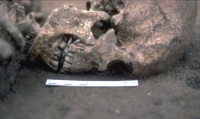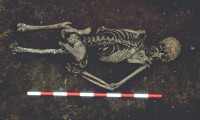 Archaeologists studying a 3rd-4th century Romano-British skeleton unearthed in 1991 at Stanwick in Northamptonshire’s Nene river valley have discovered a unique feature: his tongue was severed and replaced with a flat, round stone. He was buried facedown, a practice believed to be a deliberate act of disrespect for the dead person, or a means of shunning the deceased to counter a perceived danger to the community. This is the first burial from the late Roman period, facedown or otherwise, discovered with a stone in place of the tongue.
Archaeologists studying a 3rd-4th century Romano-British skeleton unearthed in 1991 at Stanwick in Northamptonshire’s Nene river valley have discovered a unique feature: his tongue was severed and replaced with a flat, round stone. He was buried facedown, a practice believed to be a deliberate act of disrespect for the dead person, or a means of shunning the deceased to counter a perceived danger to the community. This is the first burial from the late Roman period, facedown or otherwise, discovered with a stone in place of the tongue.
Historic England, then called English Heritage, extensively excavated more than 30 hectares the Stanwick site in advance of gravel extraction from 1984 through 1992. They unearthed evidence of human occupation in the early Iron Age. There was an established settlement on the site by the late Iron Age. That developed into an agricultural village from the late 1st century A.D. to the third. The Romano-British village prospered, with increasingly complex stone buildings replacing the circular timber structures. There was a large villa built in the 4th century A.D. and it remained in use even as the rest of the village were abandoned. Bodies were buried outside the villa walls as late as the 6th century.
The eight years of excavations unearthed more than 11,000 individually documented finds, among them more than 3,500 coins, a large collection of stone sculptures believed to have come from two mausoleums, 2.5 tons of Romano-British pottery, 1,600 samples of organic materials (plant fibers, insects, pollen), 1.4 tons of animal bones, cremation burials, 112 complete or close to complete inhumation burials and eight skulls. Thirty-six of the inhumations and one of the isolated skulls were discovered in a cemetery west of the villa. There was very little material in the graves to date them. Pottery fill used in the burials ranges from the Iron Age to the 3rd-4th century which obviously doesn’t help narrow down dates. Two copper alloy bracelets found in one burial are of a type produced in the 5th century. Archaeologists concluded that the cemetery was likely in use from the 3rd to the 5th century.
 It has taken decades for archaeologists to document, study and conserve all of this material, which is why they’ve only gotten to the stone tongue skeleton now. Osteological analysis found evidence of infection which supports the idea that the tongue was cut out since that kind of surgical intervention in our bacteria-infested mouths was almost certain to cause infection. The combination of facedown burial and stone might suggest the deceased was a criminal who was punished with tongue amputation.
It has taken decades for archaeologists to document, study and conserve all of this material, which is why they’ve only gotten to the stone tongue skeleton now. Osteological analysis found evidence of infection which supports the idea that the tongue was cut out since that kind of surgical intervention in our bacteria-infested mouths was almost certain to cause infection. The combination of facedown burial and stone might suggest the deceased was a criminal who was punished with tongue amputation.
Mays said: “There are Germanic law codes which talk about cutting people’s tongues out because they spread malicious accusations against other people. We’re looking into it at the moment, but I don’t know whether there are any Roman laws to that effect. Feedback I’ve had hasn’t indicated that there were … although that is of course still possible. We don’t know much about practices in Roman Britain as opposed to Rome itself.”
Asked how archaeologists know the tongue was amputated, Mays explained: “What gave us this idea is that there are other burials from Roman Britain where missing body parts in the grave are replaced by objects at the appropriate anatomical location. There are only about 10 of these that we’ve so far been able to identify. The great majority are decapitations, where you’ve got a stone or a pot placed where the head should be. We thought that, because of this, perhaps a stone could replace the tongue because it’s in the front part of the mouth where the tongue ought to be.” […]
He added: “The whole idea of replacing a severed body part with an object is interesting in itself. It could be an attempt to complete an incomplete body. Or it could be an attempt to replace part of a body with something obviously inanimate, like a stone or a pot, to prevent the corpse from being complete.”